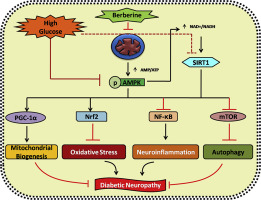Neuropharmacology ( IF 4.6 ) Pub Date : 2017-12-20 , DOI: 10.1016/j.neuropharm.2017.12.029 Veera Ganesh Yerra , Anil Kumar Kalvala , Bhoomika Sherkhane , Aparna Areti , Ashutosh Kumar

|
Adenosine monophosphate-activated protein kinase (AMPK) has been studied for its myriad metabolic and mitochondrial benefits in several chronic diseases. Recent studies have uncovered its therapeutic potential against mitochondrial dysfunction in cultured dorsal root ganglion (DRG) neurons isolated from streptozotocin (STZ) induced diabetic rats. The present study is aimed at evaluating the pharmacological efficacy of berberine (BRB), a natural AMPK activator against experimental diabetic neuropathy (DN) phenotype developed in STZ (55 mg/kg, i.p.) induced diabetic rats and neurotoxicity in high-glucose (30 mM) stimulated neuro 2a (N2A) cells. Diabetic-rats have shown reduced expression of p-AMPK (Thr 172) in sciatic nerves with a consequent reduction in mitochondrial biogenesis and autophagy. BRB (50 & 100 mg/kg, po) administration to diabetic rats for 2-weeks rescued mitochondrial functional deficits and autophagy impairment by increasing the p-AMPK expression. BRB administration also augmented the NEF-2 related factor 2 (Nrf2) mediated endogenous antioxidant defence systems to restrain neuronal damage and neuroinflammation. These effects after BRB administration resulted in enhanced conduction velocity, improved nerve blood flow and attenuated hyperalgesia. Similarly, BRB exposure (5 & 10 μM) to N2A cells attenuated high glucose induced ROS generation, mitochondrial membrane depolarization through the promotion of Nrf2 mediated antioxidant defence systems. BRB exposure augmented peroxisome proliferator-activated receptor gamma coactivator 1-alpha (PGC-1α) mediated mitochondrial biogenesis in neuronal cells. Results from this study signify the importance of mitoprotection conferred by BRB in DN and can be used as a preliminary basis for further molecular exploration.
中文翻译:

小ber碱对单磷酸腺苷单磷酸激活蛋白激酶的调节作用可减轻实验性糖尿病性神经病的线粒体缺陷和氧化还原失衡
腺苷一磷酸激活蛋白激酶(AMPK)已在多种慢性疾病中获得了无数的代谢和线粒体益处。最近的研究发现,它从链脲佐菌素(STZ)诱导的糖尿病大鼠中分离出的培养的背根神经节(DRG)神经元具有抗线粒体功能障碍的治疗潜力。本研究旨在评估小Z碱(BRB)的药理功效,小ber碱(天然AMPK激活剂)可对抗STZ(55 mg / kg,ip)诱导的糖尿病大鼠和高糖(30 mM)刺激的神经2a(N2A)细胞的神经毒性。糖尿病大鼠显示坐骨神经中p-AMPK(Thr 172)的表达减少,从而线粒体的生物发生和自噬减少。给予糖尿病大鼠2周的BRB(50和100 mg / kg,口服)通过增加p-AMPK表达来挽救线粒体功能缺陷和自噬功能障碍。BRB给药还增强了NEF-2相关因子2(Nrf2)介导的内源性抗氧化剂防御系统,以抑制神经元损伤和神经炎症。BRB给药后的这些作用导致传导速度加快,神经血流改善和痛觉过敏减弱。同样,N2A细胞暴露于BRB(5&10μM)会减弱高糖诱导的ROS的产生,线粒体膜去极化通过促进Nrf2介导的抗氧化防御系统。BRB暴露增加了神经元细胞中过氧化物酶体增殖物激活的受体γ共激活因子1-alpha(PGC-1α)介导的线粒体生物发生。这项研究的结果表明,BRB赋予DN微保护作用的重要性,并可作为进一步分子探索的基础。















































 京公网安备 11010802027423号
京公网安备 11010802027423号